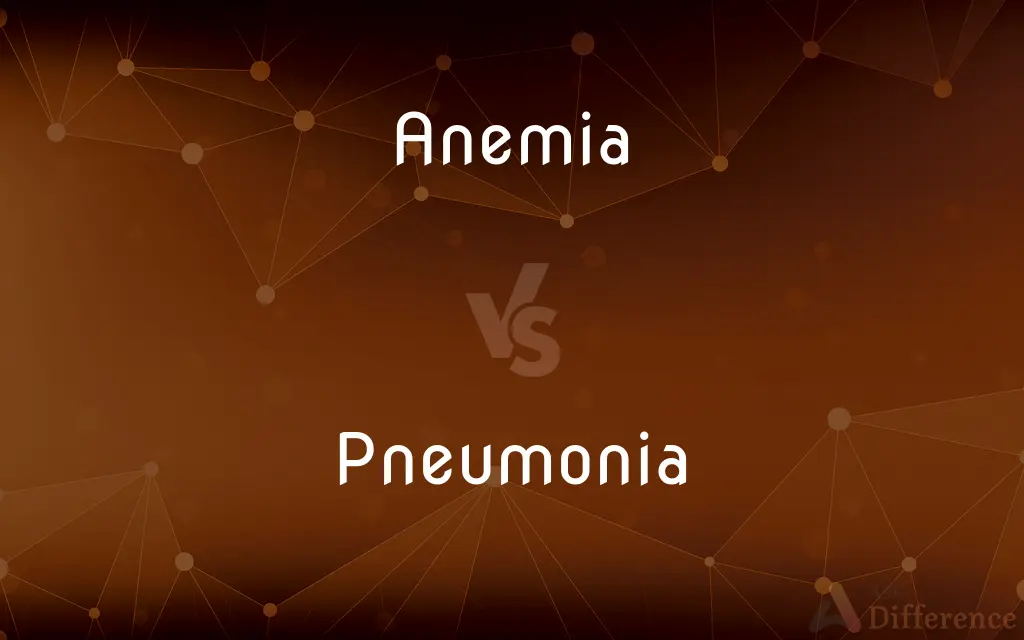Anemia vs. Pneumonia — What's the Difference?
By Tayyaba Rehman & Urooj Arif — Updated on April 17, 2024
Anemia is a condition marked by insufficient red blood cells or hemoglobin, leading to fatigue and weakness, whereas pneumonia is a lung infection causing cough, fever, and breathing difficulties.

Difference Between Anemia and Pneumonia
Table of Contents
ADVERTISEMENT
Key Differences
Anemia involves a decrease in red blood cells or hemoglobin, which are crucial for carrying oxygen throughout the body. This deficiency can cause symptoms like fatigue and pallor. On the other hand, pneumonia is an infection in one or both lungs, often caused by bacteria, viruses, or fungi, leading to inflammation and fluid-filled air sacs, manifesting as cough, fever, and breathing difficulties.
People with anemia often experience a general feeling of weakness and sometimes shortness of breath during physical activity. Whereas pneumonia symptoms are more respiratory-focused, including chest pain, phlegm production, and severe coughing that may worsen over time.
Anemia can be chronic or acute, with causes ranging from nutritional deficiencies and genetic disorders to chronic diseases. On the other hand, pneumonia typically develops as an acute condition, triggered by an infectious agent, with recovery times varying based on the individual's health and the type of pathogen involved.
Treatment for anemia depends on the underlying cause but may include dietary supplements, medications, or procedures to increase red cell count. Conversely, treatment for pneumonia often involves antibiotics or antiviral medications, along with rest and fluids to help clear the infection.
Preventative measures for anemia include a balanced diet rich in iron and vitamins, while pneumonia prevention can be aided by vaccines, especially for high-risk groups, and practicing good hygiene to avoid respiratory infections.
ADVERTISEMENT
Comparison Chart
Efinition
A deficiency of red cells or hemoglobin.
An infection of the lung tissue.
Main Symptoms
Fatigue, weakness, pale skin.
Cough, fever, chest pain, difficulty breathing.
Causes
Nutritional deficiencies, genetic conditions, chronic diseases.
Bacteria, viruses, fungi.
Treatment
Dietary supplements, medications, procedures.
Antibiotics, antivirals, supportive care.
Prevention
Balanced diet, iron, and vitamin intake.
Vaccination, hygiene, avoiding smoke.
Compare with Definitions
Anemia
Hemoglobin deficiency.
Low hemoglobin levels are a primary indicator of anemia.
Pneumonia
Respiratory condition.
Pneumonia symptoms include coughing and chest pain.
Anemia
Decrease in red cells.
Anemia often results in visible fatigue and weakness.
Pneumonia
Acute illness.
Pneumonia often requires immediate medical attention.
Anemia
A disease or condition that has anemia as a symptom.
Pernicious anemia and sickle-cell anemia are two anemias.
Pneumonia
Lung infection.
Pneumonia can cause severe breathing difficulties.
Anemia
Ischemia.
Pneumonia
Inflammatory lung disease.
In pneumonia, the lungs' air sacs fill with fluid or pus.
Anemia
A lack of vitality
Pneumonia
Infectious disease.
Bacterial pneumonia is treated with antibiotics.
Anemia
Genus of terrestrial or lithophytic ferns having pinnatifid fronds; chiefly of tropical America
Pneumonia
Pneumonia is an inflammatory condition of the lung primarily affecting the small air sacs known as alveoli. Symptoms typically include some combination of productive or dry cough, chest pain, fever and difficulty breathing.
Anemia
Iron deficiency condition.
Iron supplements are commonly prescribed for anemia treatment.
Pneumonia
Lung inflammation caused by bacterial or viral infection, in which the air sacs fill with pus and may become solid. Inflammation may affect both lungs (double pneumonia) or only one (single pneumonia).
Anemia
Chronic medical condition.
Chronic anemia requires ongoing management and monitoring.
Pneumonia
An acute or chronic disease marked by inflammation of the lungs, usually caused by a bacterium, virus, or other infectious agent.
Pneumonia
An acute or chronic inflammation of the lungs caused by viruses, bacteria or other microorganisms, or sometimes by physical or chemical irritants.
Pneumonia
Inflammation of the lungs.
Pneumonia
Respiratory disease characterized by inflammation of the lung parenchyma (excluding the bronchi) with congestion caused by viruses or bacteria or irritants
Common Curiosities
What are the signs of pneumonia?
Common signs include a cough, fever, chills, and difficulty breathing.
How is anemia diagnosed?
Anemia is diagnosed through tests that check hemoglobin and hematocrit levels.
How long does it take to recover from pneumonia?
Recovery can take a few weeks to several months, depending on the severity and the patient's overall health.
What causes anemia?
Anemia is caused by either a decrease in red cell production, increased red cell breakdown in body.
What factors increase the risk of pneumonia?
Smoking, chronic lung diseases, weakened immune systems, and old age increase pneumonia risk.
Is pneumonia contagious?
Yes, especially viral and bacterial pneumonia, which can spread from person to person.
Can pneumonia be prevented?
Vaccination and good respiratory hygiene can help prevent pneumonia.
Can anemia lead to other health issues?
Yes, untreated anemia can lead to severe fatigue, heart problems, and complications in pregnancy.
What foods are good for anemia?
Foods rich in iron, such as spinach, red meat, and fortified cereals, are beneficial for anemia.
Are there different types of anemia?
Yes, including iron-deficiency anemia, sickle cell anemia, and thalassemia.
Share Your Discovery

Previous Comparison
Sonata vs. Aria
Next Comparison
Fingerprint vs. ToeprintAuthor Spotlight
Written by
Tayyaba RehmanTayyaba Rehman is a distinguished writer, currently serving as a primary contributor to askdifference.com. As a researcher in semantics and etymology, Tayyaba's passion for the complexity of languages and their distinctions has found a perfect home on the platform. Tayyaba delves into the intricacies of language, distinguishing between commonly confused words and phrases, thereby providing clarity for readers worldwide.
Co-written by
Urooj ArifUrooj is a skilled content writer at Ask Difference, known for her exceptional ability to simplify complex topics into engaging and informative content. With a passion for research and a flair for clear, concise writing, she consistently delivers articles that resonate with our diverse audience.











































